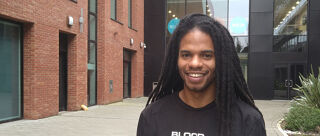Feeling worried about going on placement? It’s completely normal to feel nervous, but it’s also an exciting and valuable opportunity. Social work student, Matthew Greene, has shared his experience to give you more of an insight into what it's really like being on placement in the voluntary sector, where he worked with children and families.
Week one
My day starts at around 5 am. I begin by outlining my schedule for the day ensuring everything I need to do is planned out and timed. I then check what appointments I have booked, and make sure that my meetings have Zoom or Teams links, before having breakfast. Planning my day helps me to stay focused on my daily tasks.
My first day at placement was scary, I was given a schedule of planned-out activities for the first two weeks, meaning I had tasks I needed to get done before I was able to work on my own. I had to research local services in the area that could be beneficial to the service user group. This created an opportunity for me to arrange a support session with one of the organisations that I had found. I was extremely excited as I had only been there for a couple of days and was still able to get stuck in like this.
Week two
My second week at placement was more interesting as I was able to attend different multi-agency meetings. Interacting with people from different agencies, I was also allowed to present information about the charity during one of the meetings. Presenting to other professionals took me out of my comfort zone but I was supported throughout by my practice supervisor. After taking part in this meeting, I felt my confidence growing. Later that week I was able to join another meeting with service users and other professionals to speak about a campaign to raise awareness later in the month.
Week three
The third week was completely different - I was now able to make my schedule, contact service users, set up support sessions and plan assemblies in schools with my practice supervisor. During the first couple of assemblies, I attended I was only an observer so that I could get the idea of how it should be delivered. I started to deliver the assemblies over the next few days, changing how I delivered them according to the age groups. For younger children, I ensured the wording was not too complicated so they would understand.
During this week I also had my first assessment. Unfortunately, it didn’t go so well because I found it difficult to ask the service user personal questions. This created a barrier for me. I froze halfway through the assessment, which left me feeling frustrated because I was excited to get started but when it came to doing it, I froze.
Social Work Courses
Find out more about our courses
Week four
I started week four with a clear mind, taking what I learned from my first assessment. My colleagues gave me advice and support for future assessments, and my second assessment was a lot better. I informed the service user that some of the questions may be a bit personal, but it was the best way to find out how we could support their needs. In the end, my supervisor – who had been observing me – was pleased that I remained calm, informed the person of the reason for the assessment and that I always made sure the service user knew any silences were because I was taking notes.
Later that week, I created a poster and a video to be used on the charity’s social media channels asking the members to share their experience about isolation and how it affects them throughout the day. I was then sent documents by my supervisor that they wanted to post to choose which ones I thought would be best for social media.
So far, I have learnt so much, I have gained lots of confidence. And am excited to continue my work for the remainder of my placement. I would recommend a placement to anyone who is unsure if they should do one, it was the best decision I made.
